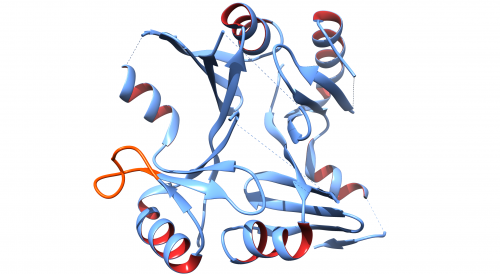Bacterial superbug protein structure solved

A research team from Vanderbilt University Medical Center in Nashville, Tenn., is the first to decipher the 3-D structure of a protein that confers antibiotic resistance from one of the most worrisome disease agents: a strain of bacteria called methicillin-resistant Staphylococcus aureus (MRSA), which can cause skin and other infections. The Vanderbilt team's findings may be an important step in combatting the MRSA public health threat over the next 5 to 10 years.
By deciphering the shape of a key S. aureus protein—an enzyme called FosB that inactivates an antibiotic called fosfomycin—the researchers have set the stage to devising a therapeutic method to inhibit FosB and hence improve the efficacy of the antibiotic. The team will present its work at the 58th Annual Meeting of the Biophysical Society, held Feb. 15-19, 2014, in San Francisco, Calif.
"Our hope is that now that we know the 3-D shape and overall function of the FosB protein, we will be able to design inhibitors of FosB that will enable fosfomycin to function appropriately as an antibiotic," said Matthew K. Thompson, a postdoctoral researcher on the team. "When we can successfully do that, we may very well be able to combat S. aureus infections with fosfomycin."
Identifying the FosB protein's three-dimensional structure helps scientists understand that protein's particular function. In particular, the new structural images of FosB, obtained by a technique called X-ray crystallography, provide insight into the functional role of a particular part of the protein's shape called a binding loop. It appears to function like a door that opens and closes to allow the antibiotic to enter the active site of FosB.
In addition to providing new insight on the function of this S. aureus protein, the research has also produced new evidence for the role zinc might play in inhibiting FosB. This could impact restoring the efficacy of fosfomycin, leading to treatment for a variety of multi-drug-resistant pathogens.
According to the U.S. Centers for Disease Control (CDC) and Prevention, MRSA poses a serious risk to public health. Studies show that about one in three people carry S. aureus in their nose, usually without any illness, and two in 100 people carry the methicillin-resistant version of the bacteria, though there is no data to show the total number of people who get MRSA skin infections.
More information: The presentation "Structure and Function of the Genomically-encoded Fosfomycin Resistance Enzyme, FOSB, from Staphylococcus aureus" by Matthew K. Thompson, Michael Goodman, Mary Keithly, Neal Hammer, Paul Cook, Kevin Jafessar, Joel Harp, Eric Skaar and Richard N. Armstrong will be at 1:45 p.m. on Sunday, February 16, 2014 in Hall D in San Francisco's Moscone Convention Center. Abstract: tinyurl.com/kxmcerd
Provided by American Institute of Physics
















